
by lisaduchene | May 18, 2023
Author’s Note: Would you join me this month to celebrate my love affair with the natural world? During May, I’m devoting most of my social media posts and all of my stories here to exploring my lifelong connection and love of the natural world, sharing the lessons of the mountains, the forest, the sea and the garden.
Pennsylvania’s forests — mostly clearcut more than 100 years ago — offer lessons in strength, resilience, and stewardship thanks to the restoration and management of the last century.
In the patches of rare, old-growth forest, like Cook Forest in Northwest Pennsylvania, there is an even deeper, richer peace to be found at the small spaces below tall, ancient trees — thanks to the conservation ethic of the Cook family.
When John Cook settled near the Clarion River in 1828 and began his logging career, he intentionally left many of the area’s towering white pines and hemlocks alone. So did his son, Anthony, and his grandson Anthony Wayne. When I needed a peaceful, restorative getaway, I went looking for it in this rare, 379-year-old forest.
We’re standing among Cook Forest’s ancient trees, walking down the hillside toward the Clarion River. All around us climb old hemlock and pine. We pause at a hemlock with a four-foot thick trunk soaring from a base of splayed roots, some more than a foot thick. The moss-covered roots, a mini-cathedral among the lichens and ferns, spark my curiosity about all that must live here – biological and mystical.
Long before I knew Cook Forest, I imagined its magic. As a child in Ohio, I knew it as the destination where my parents honeymooned in June 1969 at a family cabin. A happy time in their short marriage, presumably.
Forty years later, feeling desperate for peace and restoration, these centuries-old, mystical trees whispered to me.
There, waiting in the deep stillness and gentle snowfall of a fresh year, were ancient trees – a rarity in the Northeast, where lumbering cleared most of the virgin forests more than a century ago. The Eastern white pines in the Forest Cathedral tower 200 feet into the sky. Inside their fat trunks are the telltale tree rings marking 300 to 400 years of growth.
To be among the ancients, aware of their silent tenure, felt deeply peaceful and restorative. That first visit was the winter following my dad’s life-threatening illness over the Thanksgiving holiday, and just before our first makeup Thanksgiving dinner in mid-February, as the story goes. My core energy was depleted. I felt burned out.
I swooned for those majestic giants, soaking up their strength and quiet resilience, restoring my cup.
Then, I wanted to know their story.
A Spiritual Invitation
Dale J. Luthringer, the naturalist at Cook Forest State Park, and I hiked the Hemlock Trail through virgin forest one morning in January, 2011, a year later.
Luthringer has worked at Cook Forest for 27 years and is well-versed in the art and science of estimating the height and age of trees. Out in the woods, when pressed about why experiencing an ancient forest is worth the trip, worth the hike, Luthringer said this wild patch of Pennsylvania reminds him he is not atop the food chain.
“If you spend any time out here at all, it’s hard to not have a spiritual experience.”
Meaning: We humans are small.
Luthringer explains Cook Forest’s claims-to-fame: easily accessed old-growth stands (some ancients can even be seen from the car), year-round forest recreation, the Clarion River and a slew of tall-tree records. The Northeast’s tallest American chestnut, black cherry, Eastern hemlock, pitch pine, white oak and witch hazel all live here, along with Pennsylvania’s tallest American beech, big tooth aspen and Eastern white pine.
Cook Forest attracts foresters and scientists, tree-geeks, -lovers and -huggers – and travelers unaware they are in a forest virtually untouched since its birth after a 1644 wildfire. Some trees survived the fire and date to the early 1500s. There are 11 old-growth areas in the park, totaling more than 2,300 acres.
If not for the foresight of the Cook lumbering family — an exception to the timber barons who cut down nearly all of Penn’s Woods through the 1800s to help fuel the building of the nation — the loggers would have taken these trees, too.
“Wasteful” and “reckless” is how the historical accounts call the wood-cutting practices of that era. “Rape and pillage” is how some state foresters described it when I spoke with them several years ago for a magazine feature story about training foresters to manage Pennsylvania’s forests.
Cook’s Conservation Ethic
The conservation ethic of the Cook family offered a different legacy — and gave us the chance to experience an old-growth forest cathedral. It feels different.
John Cook, early American settler and logger, his son Anthony and grandson Anthony Wayne Cook, all protected some of the forest as John found it. Anthony Wayne Cook led a national, 17-year campaign to save more than 6,000 acres, purchased by Pennsylvania in 1927. The history is detailed in “The Cook Forest: An Island in Time” full of beautiful photographs by Anthony E. Cook.
Atop a ridge along the Hemlock Trail, the result of this history is striking. Luthringer and I walked out of the dark, ancient forest of evergreen pine and hemlock into bright sunshine. This spot – likely clear-cut 100 years ago – now grows oaks – white, red, chestnut and black – among other hardwoods. The only green this winter day is in the curled-up leaves of a dormant rhododendron and some moss on the ground.
It’s a lovely young forest. Bright and shiny. Strong and reaching — a different sensation than the deep peace I felt among the elder trees.
Soon, we are back in the virgin forest, pausing at this pedestal of primeval roots. Along with the multiple layers of canopy and standing and fallen trees, these buttressed roots, explains Luthringer, are a sign of an ancient forest.

Cook Forest, Pennsylvania.
My identification is far less scientific: a sensation of smallness and awe. I imagine Cook Forest is magical in any season, but I found winter’s stillness a rich time for my deep, necessary renewal.
These days, I recharge on weekly walks with our dogs year-round on the trails of Rothrock State Forest, 97,000 acres of public ground spanning the mountain ridges of Huntingdon, Centre and Mifflin Counties.
Dr. Joseph Trimble Rothrock, born in Mifflin County where I now live, is known as the “Father of Forestry” for his successful vision to establish a school to teach sound forest management practices at Mount Alto that later became part of Penn State University.
We often visit the deep peace of an old-growth forest in the protected Alan Seeger Natural Area, part of Rothrock Forest, where virgin white pine, hemlocks and 20-foot rhododendrons — all bypassed by the loggers — still grow, offering their peace.
~~~
Thanks for joining me on this trail, this journey. If you can, please drop me a note or comment, to let me know how you’re doing. Hearing from readers is like jet fuel for the journey.
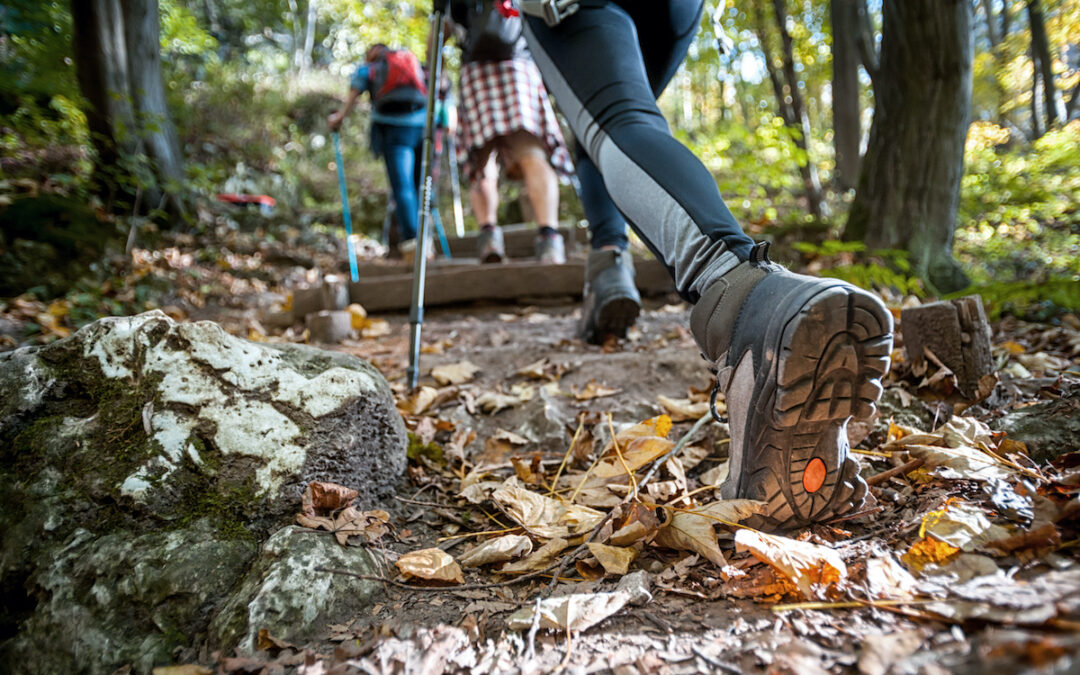
by lisaduchene | May 4, 2023
Author’s Note: Would you join me this month to celebrate my love affair with the natural world? During May, I’m devoting most of social media posts and all of my blog posts to exploring my lifelong connection and love of the natural world, sharing the lessons of the mountains, the forest, the sea and the garden.
Starting with a clear, October day on Saddleback Mountain in Western Maine, when a friend’s injury drove home one life lesson of these beautiful mountains: the power of small, steady steps.
We realized how much trouble we were in when we reached the road. Still a few miles to walk through the thick woods before we descended Saddleback Mountain in Western Maine. Daylight fading fast. Not a single flashlight among our group of five women.
Not one more thing could go wrong, I thought. One more mishap and we will be stuck on the mountain overnight in our shorts and fleece pullovers, among curious wild animals with their expert night vision and survival skills. We were low on food, clean water and warm clothes. The sky faded to pale blue, then grey.
On this October night here in the Western Maine mountains, temperatures could easily drop below freezing. The clear weather could quickly turn stormy.
All this ran through my mind, as one of the two experienced hikers who should have known better than to start so late, leaving no time for the injury our friend sustained at the summit. Now, we all understood the consequences of one more misstep.
At least we were still moving. Slowly.
Women’s Weekend Adventure Takes a Turn
Our Saturday of girls’ get-away weekend had been sun-drenched and spectacular until the afternoon. One of those crisp, crystal-clear October days that started sunny and cool, then warmed to a comfortable day of mountain climbing and chit-chatting, plenty warm in shirt-sleeves. Our 12-mile, round trip route took us on a dirt path into the forest, fragrant with the scent of crushed pine needles, and ground bits of dried leaves. Gold, crimson and flame orange speckled the canopy of birch, maple, oak and balsam pine.
The footpath hugged the small Ethel Pond, then a bog named Eddy Pond and began a steep climb over root and rock toward the summit. Blue sky and bedrock, sweat and hand-over-hand grit marked that steep final mile to the summit, 4,126 feet above sea level.
Back then, in my 20s, I hiked a lot.
I did not grow up among mountains, but chose them for their beauty. For the excitement of exploring and getting to know them. For the anticipation of satisfaction and views from their summits. For their lessons.
Maine’s seacoast clinched the deal, once New Hampshire’s White Mountains had hooked me on living near wild places in northern New England. My paperback copy of the sage green Appalachian Mountain Club hiker’s guide with a pocket for the thin, paper fold-out maps was dog-eared and dirty from the trail. I went with buddies, and groups and alone several times a season.
Each summer, I’d celebrate my birthday by hiking a mountain of at least 4,000 feet, an ever-taller peak until I finally climbed Mount Washington — at 6,288 feet the highest in the Northeast. Since that climb, any mountain would do. Katahdin. The Bigelow Range. Cadillac in Acadia National Park.
Standing on the summit is a sweet rush of triumph, of conquest. My two feet, breath and sheer will combine to carry me from the parking lot up to this spot, higher than anything else I can see around me. Close to the clouds. The closest I can get to heaven. I love it even when my heart is pounding and my legs are screaming “enough!”
On those big climbs, I’d often pause at a clearing midway up the mountain to turn and look back at how far my feet had carried me. One step at a time.
The mountains’ lesson: Baby steps add up to big journeys and accomplishments.
On this October evening on Saddleback Mountain, I needed them to add up to safe passage back to the car for all of us.
That afternoon, just before I reached the summit with its views overlooking tree-covered mountains and shimmering lakes, I heard the news.
My friend in our group — a strong, tall and capable fitness instructor and trainer — had suffered the quick onset of a migraine headache. Seeking relief, she began her descent and stumbled. She rolled her foot completely to one side, then to the other. Later, we would learn she tore every ligament in her foot and would be on crutches for weeks.
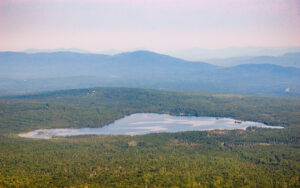
Mount Saddleback, western Maine.
Delicate, Deliberate Descent
In tremendous pain, she could not put any weight on her foot. One step at a time, she leaned on two other women to descend the steep, stone steps. We were three abreast, on narrow, rocky steps that are tricky footing for anyone.
We were slow and steady, concentrating on our footing. We took turns helping our friend and stayed positive and encouraging. Our group included fitness instructors, trainers and an experienced hiker. She also knew better than to be caught on the trail this late in the day without a flashlight.
Slow and steady, one careful step at a time, we had managed to descend the steepest, rockiest stretch from the peak down. By dusk, we reached the road where people were camping. Another friend — the other experienced hiker in the group who also regretted our late start — spoke with a camper and fellow hiker. She confirmed our location and borrowed a flashlight. We promised to leave it at his truck on our way out.
We would be OK, as long as nothing else went wrong.
And so, ultra-careful of our footing, we took baby steps as a group shared the flashlight. No one wanted to barrel ahead, trip and risk another injury.
We stood still and patiently in the dark with our injured friend, as our other seasoned hiker used the flashlight to walk 10 feet ahead then stopped, turned around and shined the light on our path. We walked carefully, alerting each other to obstacles like roots and rocks, as far as we could see.
We repeated the process, many, many times.
Our slow and steady baby steps, patience and cooperation did the job. We reached the parked car sometime around 9 or 10 p.m. without further mishap. We were tired, filthy, hungry — and safely off the mountain.
We returned the flashlight to the truck of the friendly hiker we’d met on the road.
We drove the 10 miles back through town to our cabin on Rangeley Lake, where we heaped ice upon the swollen foot and ankle of our injured friend, re-hydrated with water and wine and shared a late dinner. Most of us bounced back in the next couple of days, while our injured friend had many weeks of recovery ahead.
A few years later, I returned to Saddleback with two other friends for a day-hike on a hot summer day. We started early in the morning, reached the summit, relished the spectacular views and returned to the porch of our lakeside cabin by dinnertime.

Saddleback Mountain
Mountains of my Heart
Flat terrain holds no appeal for me.
These days, I live surrounded by mountain ridges in central Pennsylvania’s Ridge and Valley province, glad to live in the Appalachian Mountains for all the beauty, peace, experiences among forest, stream and trail they offer — and their lessons.
Lately, the tall peaks with alpine forests and stunning vistas have been more prominent in my dreams than my day-trips. But I’ll always be on the trail, breathing in fresh air nourishing to body and soul and still marveling at how small and steady steps lead to triumph.
Thanks for joining me on this journey of journeys. Our connection to the natural world matters. We can’t save what we don’t know and love. These connection points are beacons of hope. Read more: Our “Guiding Lights”.

by lisaduchene | Apr 27, 2023
How to celebrate my stepson’s wedding with my lifelong family and friends? We created a “bonus” event — then had even more happy news to share.
As I hand-addressed invitations to a party for their upcoming wedding, my younger stepson and his fiancée called from Pennsylvania with some big news. I was in Cleveland, visiting my mom and stepdad. My husband, who was home with the couple, put the call on speaker. Listening closely, I noticed a grainy grey image of a sonogram arrive on the screen of my laptop.
Then our kids shared their happy news.
Feeling a rush of pure joy, I announced loud and proud, so my mom and stepdad could hear in the next room:
“We’re having a baby!”
My heart pogo-bouncing in my chest, I congratulated the new parents, both teachers who are fantastic with kids. A year into our lives as grandparents, my husband and I know this bliss.
Then my stepson, the baseball player and peanut butter prankster, relayed that the due date was only 12 weeks away. My mind began to absorb what it saw in the picture: A perfect, tiny baby shape. A fully formed head with a clear profile, inward curve of the baby’s eyes, a nose, lips and chin.
Their first child, our second grandchild, arriving very soon. Any day now, as I write.
Surprise!
She had felt fine, with no symptoms, so was almost as surprised as we were in that moment. In the coming weeks, our family digested the news, shook off the shock and plunged into preparation mode to help these two get ready for a baby and wedding already planned for this summer. Thanks to an upcoming event we’d created for my older stepson’s wedding, I would get to share this joy with people I’ve known my whole life. Out went the invitations to the Bonus Party.
 Weddings are Tricky Territory for Step-Parents
Weddings are Tricky Territory for Step-Parents
“Bonus” parent is what some people call stepparents, a much kinder term and image than Disney ever gave us stepmothers. So when we created an event to celebrate a family milestone with my family-of-origin in Cleveland, I named it “bonus.”
The idea hatched as my older stepson drove his fiancée and me to a family camping trip soon after they got engaged. He had proposed to our daughter-in-law, his high school sweetheart on a summer night at the beach, dropping to one knee in the warm light of the boardwalk as his brother tossed him the ring box. The neon sky-blue of the Ferris wheel rose in the distance. His fiancée was already part of our family, so we were thrilled, eager to share the news and celebrate.
On our drive, my stepson said they were working on the guest list for the wedding and posed a tricky question: Who should they invite from my “branch,” my extended family and friends? You know, all those people with whom I’ve celebrated life’s milestones. He knew my mom and step-dad, so they were already on the guest list. My dad had died more than five years earlier.
But what about my aunts and uncles and friends? He knew a few, but not all of them. Weddings and step-parents can quickly lead to tension and conflict, not to mention the question of celebrating with a step-parent’s family.
I felt honored that he asked, but it raised a thorny problem. It wasn’t right to invite only some of my aunts and uncles. It would need to be all or none of them, and the names would quickly add up. I could not imagine requesting that. Entitlement on my part would only add to friction.
Nor did I think it was right to expect a bride and groom to get acquainted with new people for the first time at their wedding, especially if you, like me, swoon at the idea of your people forming rich connections with each other. Instead, these conversations would be a blur.
Still — this was a big, happy milestone I wanted to celebrate with my tribe, my family-of-origin and my friends. What to do?
A Little History
Quick background: My stepsons were teenagers when their dad and I fell in love 12 years ago. (Read You Had Me at Pears.) From our first conversation, my husband’s exceptional fathering, his willingness to sacrifice for his boys, has been one of the things I love most about him. Partners who already have children are a package deal, so I married all three of them.
My role, I soon realized, was to unconditionally love these two boys — no strings attached, except that they be polite. Even respect is earned.
Often easy. Occasionally hard. I’m not a saint.
But I can easily slip into the kids’ shoes, and know this tricky territory. I grew up a child of divorce and was four when my own father re-married. “Family of origin,” after all, begins with our parents. I am aware that I will always in some way be an intruder.
For the record, they have a mom who loves them very much. I also consider them to be our kids. I’m not enamored of the “step” label, but it is accurate and an important word. “My” stepsons. “Our” kids.
“Step,” I realized, means to “step up.” Another way to say “I choose you,” and you are a part of me, even if it’s not biologically speaking.
In the context of a wedding, though, I’ve come to believe “step” means “step back.” This day has to be all about them.
Fancy Pizza, Wine, Twinkly Lights — and Snow
So back to that talk about the guest list: Only my mom and step-dad should be invited, I told my elder stepson, then had an idea.
“What if dad and I hosted a special dinner for you both in Cleveland with my family?”
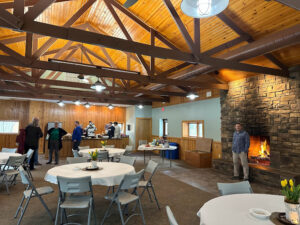 They liked it — and our “bonus dinner” with my tribe was born. I called my aunts and uncles to explain the plan. They were gracious and understanding.
They liked it — and our “bonus dinner” with my tribe was born. I called my aunts and uncles to explain the plan. They were gracious and understanding.
So in January 2020, my husband and I hosted a big family dinner at a newly opened swanky winery and restaurant southeast of Cleveland, with my relatives, our immediate family, including of course my stepson and his fiancée.
We reserved a big Air BnB house for the weekend in the sweet little town of Peninsula for 10 of us, who traveled from Pennsylvania.
Despite several inches of snow falling that early January evening, our guests came out to celebrate. My aunt, not a big fan of traveling, came from New York. My uncle re-arranged travel plans to attend. People I love so much, who hardly see each other due to geography and circumstances, got to know each other a little better over fancy pizza, salad and wine in a private dining room. The bride-to-be and groom had fun, exploring the winery and practicing their dramatic dip for their upcoming wedding. (Four months later, my handsome stepson dipped his beautiful new bride as they left for their honeymoon, surrounded by guests holding sparklers. A gorgeous image.)
I soared on the connection among loved ones that winter night. The Bonus party turned out to be a big success.
Gathering Around the Fire
Soon after my younger stepson and his girlfriend got engaged last summer, my husband and I offered a “Bonus” celebration with my family in Cleveland.
They happily accepted, and my inner party-planner flew out of the gate. We are thrilled to officially welcome this lovely, kind young woman — and grandchild — into our family, sharing the excitement of this chapter as our kids make their own families.
The winery did not seem right for this outdoors-y couple. My mom suggested a lodge in the Cleveland Metroparks, a vast network of woods and trails and picnic spots, and our bride and groom liked the idea.
We gathered all the party gear and packed for Cleveland. We would miss my mom and stepdad, who was in the hospital following a surgery, and a few cherished out-of-town relatives.
Our guests, including the bride’s parents, arrived to a roaring fire, a spread of sausage and pepper sandwiches and potato salad, and tables dressed with ivory cloths and yellow tulips.
People talked and joked and laughed and got to know each other a little better. We took lots of pictures in front of the stone fireplace and had fun chasing our one-year-old grandson around. My best friend from high school came with her whole family, and we sang to mark the milestone of her son’s 21stbirthday.
More to Celebrate
Another festive, successful Bonus event. We laughed together over ideas for baseball- and funny aunt-inspired baby names, ate strawberry shortcake and the cutest cookies decorated to look like little baby onesies with green and yellow stripes. I was in heaven, so grateful for the connection-rich time with loved ones.
A unique family gathering, as it should be because every family has its own story. Ours might just evolve to find new excuses to host more Bonus events.
Bonus parenting comes with a couple of simple rules — deeply love those kids with all of your heart and commit to figuring it out together, over time. The precious gift worthy of celebration is a chance to help remake family, build function and help hearts to heal. Especially your own.
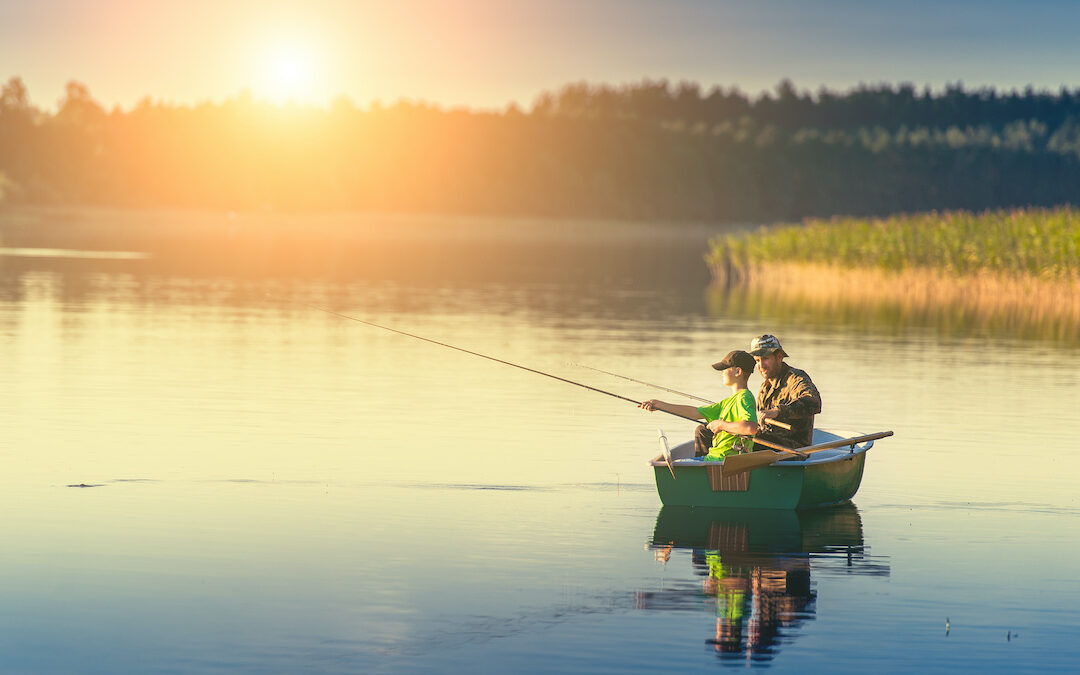
by lisaduchene | Apr 20, 2023
Families gathered at the creeks on the first day of fishing season spark my hope that we as humans can heal our relationship to the natural world. Despite a challenging reality, there is so much beauty and love still to be found in our connection to nature.
The boy turned and smiled as he told me about the fish he’d just caught. A cute kid, about seven, with a wide, toothy grin, freckles and ears he’ll grow into. He and a woman, presumably his mom, wore rubber boots and had just loaded fishing poles and a net into their car.
I passed them near the lake at Greenwood Furnace State Park in central Pennsylvania.
Celebration was in the air. Parents brought their children to the lake that morning on the first Saturday of April to fish on Opening Day of Trout Season. Just after 10 a.m., two hours in, I asked him if he had caught a fish.
Yes, he answered, beaming.
A salmon, I think? he said.
No, said his mom, a trout! You caught a TROUT!
She chuckled and tousled his hair with her hand. Get in the car, she nudged.
It’s OK, I called out, smiling, as we walked on. You’ll learn their names!
Off they went. On I walked with our dogs past the picnic pavilions and toward the campground, feeling lighter and more hopeful after sharing that thrill of reeling in a fish.
A beautiful moment of a child enjoying an exciting connection with the natural world.
For me, a hopeful reminder that despite an urgent need for humans to find balance with nature, there is still so much beauty, love and comfort to be found in our connection to nature.
‘Guiding Lights’
Maybe this little boy will always remember catching that trout, the way I remember exploring the woods as a kid or turning over rocks near Tinker’s Creek within the Metroparks, an emerald network of wild places, woods and waterways that offer escapes from the housing developments and strip malls of suburban Cleveland, my hometown.
No single moment like this saves the world — and yet, they all matter because they can help us heal our collective relationship with nature.
These memories are “calling cards to the wholeness of a human lifetime, strongly rooted in your nature,” write social-psychologist Mary Clare and science writer Gary Ferguson in their excellent book “Full Ecology, Repairing Our Relationship with the Natural World.”
Short version: Our innate connection to nature means we can still heal that relationship. There is still time.
Clare and Ferguson’s message is a hopeful one that makes a lot of sense to me.
Their book begins with a photo of Mary Clare as a little girl, standing with her sister in a pond with water up to her shins, looking for tadpoles, then a picture of Gary Ferguson as a kid standing on the sandy shoreline of Lake Michigan feeding seagulls with his dad and brother as waves roll toward them.
These moments are guiding lights, they write.
“Guiding lights showing the way back to the landscape of your being. A homecoming, as uncomplicated and mysterious as tadpoles in an alpine pond or seagulls dancing above the dunes,” they write.
Everything is Better Outside
My love affair with the natural world began as a kid at the shallow Tinker’s Creek, where I learned everything is better outside, among the trees and the sound of water moving over rock.
My mom would pack up eggs, milk, cinnamon and bread, and kitchen gear. We’d spread out at a picnic table. She’d start a charcoal fire in the grill, then mix up the batter, soak the bread and cook a French toast breakfast for us on the griddle.
After breakfast, we’d pick our way along the creek, turning over rocks — even though I don’t remember much except feeling squeamish about what we might find. The joy was in the looking, the exploring.
We’d walk the trail through the woods to climb a big boulder.
Later, when I was in college and it was time for me to figure out where to live next, we walked together in the forest in New Hampshire’s White Mountains. On that trip, I realized people could live within big, wild, natural places — where the forest or the mountain or the sea was a constant, dominating presence more powerful than freeways and parking lots and shopping malls. I wanted that life.
First Assignment: Heartbreaking Loss
I chose Maine for the water. Almost every turn on my first drive in Maine took me to a lake or river and eventually the ocean. Soon, I had my first pro-writer job, telling the stories of Maine fishermen.
The iconic cod stocks off the New England coast, so key to colonial America, were crashing and no one really fully understood why. The scientists said it was too much fishing. The fishermen said the scientists were poor fishermen and didn’t know where to look for fish.
Turns out Atlantic cod is likely one of the early losses to climate change in the Gulf of Maine, which is warming faster than 99 percent of the global ocean. Those rising temperatures are pushing many species north and there is much concern about when the waters will become too warm for Maine lobster.
So began my three decades and counting, of researching and telling stories about our human relationship to nature, often through the lens of fishing, gardening, farming, or eating. All ecological acts. All connecting points to the natural world.
Intimate Connection
Now, I live in Pennsylvania, with thick forests and dark, swirling trout streams that draw fly fishermen from all over the world.
I have long believed that conservation isn’t so much about “saving the environment” — this other, separate thing — but to save our own life-support system, to save ourselves.
We eat. We breathe. We drink water. We cope with or bask in the weather. We fish. We garden. We walk in the woods. We go to the beach to have fun and relax. We are all intimately connected to nature every day, whether we think of ourselves as outdoorsy — or not.
We’re also already living in the midst of climate change.
Seeking Woods and Water
So I come to the park to walk, to get out of my head and refresh my spirit among the woods and water.
I felt joy to be in a place awash in spring light, to see the forest floor wake up with green, to see so many little groups of families fishing and camping together.
This place with its lake and meadow of wildflowers, trails through the woods, memories and old stone buildings never fails to inspire me. It is a symbol of healing.
The house, the Ironmaster’s Mansion, is a remnant of the buildings and community that sprouted here to support the iron-making operation that peaked in the early 1880s. The stone furnaces blasted iron ore into pig iron ingots hauled away to become wrought iron. Charcoal made from the burned wood of cut trees fueled the furnaces. Read the history here.
About a century ago, Pennsylvania cut most of its forests to the ground. Now we have 2.2 million acres of state forest here, helping to clean and protect our air and water.
By 1842, a dam and spillway was built to create the lake to supply water and power to a gristmill.
The same lake now stocked with trout.
To see people delight in nature leaves me hopeful that we can heal our connection — and give this kid and all of our kids a much better shot at a full, healthy and peaceful life.

by lisaduchene | Apr 14, 2023
| Big Valley here in central Pennsylvania bursts in bright green, full blossoms and new life. Grasses and early crops turn our fields spread on the valley floor more lime and chartreuse than brown. On the mountain ridges, speckles of green swell. Friends and neighbors are posting pictures full of the sweet, tender faces of chicks and just-born lambs, goats and calves.
After about a week away in my hometown of Cleveland, I returned this afternoon to find spring in full swing. There, too. These last few mornings I ran around my mother’s garden, photographing daffodils and Lenten rose, clematis buds and white blossoms of verbena.
But back home, my heart soars for Appalachian Spring. A few warm days unleashes this explosion of green. Our flowering trees erupt in the most perfect, delicate and fragrant white, pink and salmon blooms. The magenta redbud trees lace the roadside edges of the forest.
Temperatures reached the mid-80s today, a disturbing and dramatic departure from the average temps in the 60s. Last year, my photo archive tells me, we had snow on April 19. The redbuds did not bloom until late April.
Somehow, this spring unfolds even faster than usual. I always want to slow it down and find a way to wrap my arms around it and hang onto it. But then it would not be so special.
Spring Break
I’m taking a little “spring break” to post today with a roundup of the last several stories, just in case you missed any?!
This season of growth is exciting here at ThanksgivinginFebruary.com, too. I’ve been working hard on some new pieces and revising and reworking some from the archive. I’ve always loved the re-writing and revising work as much as that initial flash of inspiration that begins a piece.
Even more exciting to me is to pull out a “good” piece from a year ago, and see how much better it can be. This week, I reworked a story on making my grandmother’s recipe for “pascha” Easter bread: “Baking Bread Offers Connection.”
Last Saturday, for the first time, my mom and I made pacha together. It was a nice respite.
My goal is for these posts to be about a five-minute read. Getting there!
One more bit of fun news to share: I’m working with a favorite former editor to help polish the reflections and stories here. After a few years of DIY everything on this site, it’s nice to work on these pieces with an editor and friend — one who won’t let me get away with anything.
I’m posting here every Thursday. Follow on social, or sign up for the email list. Connect here.
Enjoy! Happy Spring!
The latest posts:

How do we cope with missing loved ones? Baking our family’s Slovak Easter bread helps me find strength and comfort in connection. Read more

We are all afraid of failure from time to time. Even Major League pitchers. Even writers. To conquer that fear: Trust Your Stuff. Read more.
Recalling visits to baseball spring training, watching the players and soaking up all that sunshine warms a restless and chilly night. Read more.
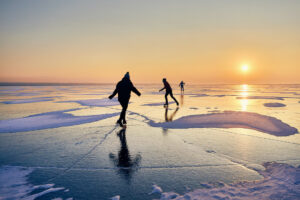 Ah life! Anything can happen on any day. God is in control, many of us believe. Or fate. Or destiny. Even if it’s an illusion, I work toward a sense of control. Read more.
 Focusing on my small patch of fabric in the giant quilt of the world is a good reminder when I catch myself taking on the weight of the world’s suffering. Read more.
And here is one of my very favorite spring pieces:
House Rules: From Peanut Butter Pranks to One Big Rule
|
|
|
|
(more…)







 Weddings are Tricky Territory for Step-Parents
Weddings are Tricky Territory for Step-Parents They liked it — and our “bonus dinner” with my tribe was born. I called my aunts and uncles to explain the plan. They were gracious and understanding.
They liked it — and our “bonus dinner” with my tribe was born. I called my aunts and uncles to explain the plan. They were gracious and understanding.




